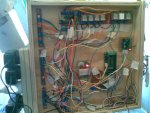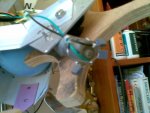michael boyd
Member
In my current project, I use a 5 volt plugpack for the picaxe, 6 volt plugpack to run servos and a 12 volt plugpack to operate toy motors and solonoids.
A 240 volt item is plugged into a 240 power board with the addition of all the various plugpacks.
I find it all very messy and space consumming as well as the plugpacks are not earthed. There is interference activating inputs when when other items are running. Could having it not earthed contribrute to this?
Is there a better way? I found this at our electronics retailer
http://www.jaycar.com.au/productView.asp?ID=MP3108&keywords=transformer+5+12&form=KEYWORD
I was thinking in future (or re-doing this project) by using one of these. Running the servos on 5v (due to there electrical noise, I am not sure if they will interfere with the PICAXE) . I would wire a 240 volt outlet onto the in side of the tansformer. This would allow me to EARTH everything easier and neater.
What do you think?
regards
Michael
A 240 volt item is plugged into a 240 power board with the addition of all the various plugpacks.
I find it all very messy and space consumming as well as the plugpacks are not earthed. There is interference activating inputs when when other items are running. Could having it not earthed contribrute to this?
Is there a better way? I found this at our electronics retailer
http://www.jaycar.com.au/productView.asp?ID=MP3108&keywords=transformer+5+12&form=KEYWORD
I was thinking in future (or re-doing this project) by using one of these. Running the servos on 5v (due to there electrical noise, I am not sure if they will interfere with the PICAXE) . I would wire a 240 volt outlet onto the in side of the tansformer. This would allow me to EARTH everything easier and neater.
What do you think?
regards
Michael


